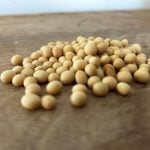Bryce Geisel likes to share a fact about nitrogen stabilizer products that many farmers might not recognize: Not all stabilizers are created equal.
Geisel, the senior agronomist and representative of Koch Agronomic Services (KAS) in Regina, explains while all companies will promise product performance, there are many that don’t provide enough active ingredient to be agronomically effective.
“So, farmers need to ask questions about active ingredient loads when you’re choosing a nitrogen stabilizer,” he says.

Koch Agronomic Services
Understand the loss type you need protection from
“As we go into spring, we have to be concerned with nitrogen loss pathways,” says Geisel. He notes those pathways can differ by nutrient source, application method, timing and weather, to mention just a few factors. All nitrogen is subject to loss one way or another, so protecting it is key.
“Volatilization is the biggest loss pathway in the West,” he says. “It happens only with urea and UAN, and losses can be as much as 40 to 45 per cent in extreme cases, but 10 to 25 per cent is pretty standard for most farmers.”
Volatilization occurs when urease, an enzyme found in all soils, converts N into a gas. Geisel says Prairie soils, with their higher pH and plant residue loads, almost seem built for it. “Volatilization should be a concern for all farmers.”
While the other two loss pathways, leaching and denitrification, are less frequent concerns for western farmers, Geisel points out that all forms of N are subject to loss if conditions favour the microbial activity necessary to kick them off.
“Leaching isn’t a major issue in Western Canada – yet,” he explains. “But with more tile going in, it’s becoming a bigger concern. Denitrification, on the other hand, is common with spring snowmelt or heavy rainfall events.”
The role of N stabilizers
Nitrogen stabilizers contain two key active ingredients: urease inhibitors, which slow urea conversion to ammonium, and nitrification inhibitors, which delay ammonium’s conversion to nitrate. Geisel emphasizes that an effective stabilizer should have strong levels of both – backed by solid performance data.
Nitrogen loss follows an S-shaped curve,” he explains. “It begins gradually, then accelerates as urea converts to ammonia before tapering off. Stabilizers help regulate this process, extending nitrogen availability over time. Since nitrogen is often applied before the plant needs it, the goal is to slow its conversion to nitrate, ensuring availability when the crop needs it most.”
Effective levels of AI are key to achieving that goal and Geisel says KAS’s N stabilizers have been designed and extensively tested to ensure they deliver just that.
ANVOL™ protects against volatilization with AIs Duromide, a patented technology, and NBPT, the combination of which provides the longest-lasting protection over a wide range of environments.
“Apply ANVOL with urea or UAN,” says Geisel. “It’s an excellent choice for spring applications, particularly for crops like canola that require early nitrogen. Whether you’re broadcasting, or shallow or streamer banding, ANVOL helps extend nitrogen protection, ensuring greater efficiency and availability.”
“TRIBUNE™ is just for use with UAN,” he says. “It has NBPT and our patented AI, Pronitridine, to protect N from all three forms of loss.” He notes this technology means TRIBUNE binds to the soil, keeping the inhibitor close to the N that needs protection.
“SUPERU™ is a 46-0-0 urea fertilizer with NBPT and DCD built into it,” says Geisel. “The reason we do this is to ensure the right rate of DCD needed to be agronomically effective is on every granule.”
Geisel says there’s a time and place for each product. “Go to your four Rs,” he says. “If you’re putting N more than two inches down in bands, you may not need a stabilizer. But if you’re broadcasting, shallow or dribble banding – protect it. Think responsibly about it. Why pay for N if you’re just going to lose it?”
For more information, visit DefendYourN.ca.









